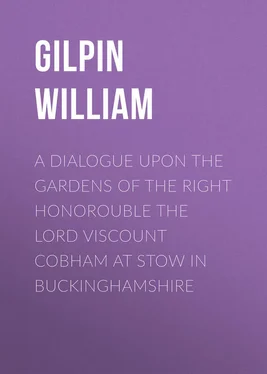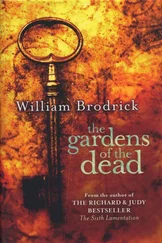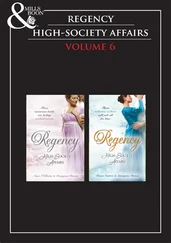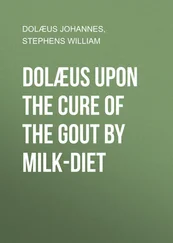William Gilpin - A Dialogue upon the Gardens of the Right Honorouble the Lord Viscount Cobham at Stow in Buckinghamshire
Здесь есть возможность читать онлайн «William Gilpin - A Dialogue upon the Gardens of the Right Honorouble the Lord Viscount Cobham at Stow in Buckinghamshire» — ознакомительный отрывок электронной книги совершенно бесплатно, а после прочтения отрывка купить полную версию. В некоторых случаях можно слушать аудио, скачать через торрент в формате fb2 и присутствует краткое содержание. Жанр: foreign_antique, foreign_prose, на английском языке. Описание произведения, (предисловие) а так же отзывы посетителей доступны на портале библиотеки ЛибКат.
- Название:A Dialogue upon the Gardens of the Right Honorouble the Lord Viscount Cobham at Stow in Buckinghamshire
- Автор:
- Жанр:
- Год:неизвестен
- ISBN:нет данных
- Рейтинг книги:5 / 5. Голосов: 1
-
Избранное:Добавить в избранное
- Отзывы:
-
Ваша оценка:
- 100
- 1
- 2
- 3
- 4
- 5
A Dialogue upon the Gardens of the Right Honorouble the Lord Viscount Cobham at Stow in Buckinghamshire: краткое содержание, описание и аннотация
Предлагаем к чтению аннотацию, описание, краткое содержание или предисловие (зависит от того, что написал сам автор книги «A Dialogue upon the Gardens of the Right Honorouble the Lord Viscount Cobham at Stow in Buckinghamshire»). Если вы не нашли необходимую информацию о книге — напишите в комментариях, мы постараемся отыскать её.
A Dialogue upon the Gardens of the Right Honorouble the Lord Viscount Cobham at Stow in Buckinghamshire — читать онлайн ознакомительный отрывок
Ниже представлен текст книги, разбитый по страницам. Система сохранения места последней прочитанной страницы, позволяет с удобством читать онлайн бесплатно книгу «A Dialogue upon the Gardens of the Right Honorouble the Lord Viscount Cobham at Stow in Buckinghamshire», без необходимости каждый раз заново искать на чём Вы остановились. Поставьте закладку, и сможете в любой момент перейти на страницу, на которой закончили чтение.
Интервал:
Закладка:
Variety had, of course, always been essential to the English garden and is a special feature of Stowe, as Pope implies in the Epistle to Burlington and as the writer of the appendix to Defoe's Tour of 1742 explicitly stated. 8 8 "There is more Variety in this Garden, than can be found in any other of the same Size in England , or perhaps in Europe " (p. 290).
What we have in Gilpin's Dialogue is both valuable evidence of response to garden structures, the visitor's rather than the designer's or client's account, and some hints of how the idea of variety, itself a painterly term, presented itself to Gilpin in the days before his picturesque tours.
Gilpin's path through the gardens at Stowe is recorded in the Dialogue as a journal of the mind's responses: the Advertisement (p. iv) prepares the reader for this with its insistence upon the role memory has played in its composition. The varieties of mental experience are sometimes registered by the dialogue form; more often the two visitors share responses which correspond to the changes of Stowe's scenes. This is most amusingly illustrated by the "impertinent Hedge" that suddenly blocks their view (p. 11); Callophilus' ingenious explanation, a curious parallel to Sterne's blank page in Tristram Shandy , is that thereby the visitor's "Attention" is kept awake (p. 12). More strenuous is their intellectual involvement with the monuments, statues, and inscriptions in the Elysian Fields (pp. 19ff), emblems that provoke in Callophilus "a Variety of grand Ideas" (p. 29). Yet, as the text of the third edition makes precisely clear (p. 11), in face of the same objects his companion is more fascinated than he with the formal elements of an art – contrasts in landscape textures, style of inscriptions (p. 30), or unadmirable workmanship in bas-reliefs (p. 37). The "Subject[s] for … Rapsody" (p. 30) that Polypthon mocks were an essential aspect of any Augustan garden, and six pages later they divert even Polypthon himself into moralizing. But his stronger inclination is to ignore the iconographical problems of the Saxon busts (p. 44) and gaze "into the Country" where his companion solicitously directs his attention to the elegant woods (p. 45).
The Dialogue allows these and related distinctions to emerge, even though it does not grapple with their implications. As Callophilus explains, there should be a grand terrace for strangers, and the shade of a "close vista" for friends (p. 31). Stowe provided both, just as it catered to the propensity for retirement – the Hermitage, the Temple of Friendship, or the Temple of Sleep – as well as for the obligations of public life – the Temple of British Worthies, the gothic Temple of Liberty. The most emblematic items in the gardens, upon which Callophilus predictably expatiates because they were designed to be easily "read," are in the public places, where they firmly control the visitors' mental reactions and leave less scope for the private and enthusiastic reveries of Polypthon. It is a fair assumption that most visitors to the Temples of Liberty or Ancient and Modern Virtue would have understood their meanings just as Callophilus did (pp. 40 and 19-21).
But the aesthetic taste of Polypthon for the forms and shapes rather than the meanings of landscape betrays a potential for less controlled and more private rhapsodies. His quest "after beautiful Objects" (p. 24) takes him as much to the northern parts of Great Britain as to gardens like Stowe, and is obviously prophetic of Gilpin's own picturesque travels. Like Warton's Enthusiast or the Lover of Nature (1740), Polypthon rejects "gardens deck'd with art's vain pomps." This is because he is fascinated with the more radical landscapes of solely formal elements – the serpentine windings of the river at Stirling (p. 44) or what has been called the abstract garden 9 9 Derek Clifford, A History of Garden Design (London: Faber, 1962), pp. 138-9.
that comes to fruition only in the decades after Gilpin's visit under the management of "Capability" Brown. But the fact that Polypthon finds sufficient abstract patterns to engage his attention at Stowe suggests that the Brownian mode was already latent among the richnesses of the Buckinghamshire gardens.
The "rejection" of Stowe by Polypthon as by Warton also signals their desire to indulge the enthusiastic fit. His very first reaction upon arrival at Stowe is an "Exclamation" that expresses his expectations of aesthetic delight (p. 2). Although his companion is equally susceptible and is accused by Polypthon of being an "Enthusiast" (p. 49) and in the third edition of the Dialogue (p. 12) determines himself to "indulge the thrilling Transport," it seems to be Polypthon whom Gilpin intends to characterize by expressive as opposed to explanatory outbursts as they proceed round the gardens. And it is he who concludes their visit (p. 58) with a catalogue of the various human moods for which the gardens cater, rather more extravagant in its expressive fervour than Callophilus' traditional identification of the passions on faces of other visitors (p. 51).
Gilpin's attention to his characters' intellectual and emotional reactions illuminates the roles of poetry and painting that have always been associated with the rise of the English landscape garden. 10 10 "Poetry, Painting, and Gardening, or the Science of Landscape, will forever by men of taste be deemed Three Sisters, or the Three New Graces who dress and adorn nature": MS. annotation to William Mason's Satirical Poems , published in an edition of the relevant poems by Paget Toynbee (Oxford: Clarendon, 1926), p. 43. For an anthology of similar comments see The Genius of the Place: The English Landscape Garden 1620-1820 , ed. John Dixon Hunt and Peter Willis (London: Elek, 1975).
If Milton's description of the Garden of Eden, so frequently invoked by eighteenth-century gardenists, implied an informal structure for designers to emulate, it equally encouraged associationist activity in gardens. The visual reminders of literary texts at Stowe — Il Pastor Fido (pp. 2ff) or Spenser (pp. 6-7) – which are sometimes accompanied by inscriptions which articulate the "dumb poetry" of the decorations (e.g., p. 13) serve mainly to provoke the imagination of visitors. Sometimes, as at the Hermitage, Stowe's designers force specific associations upon the mind; elsewhere they are content to manipulate the feelings in such a way as to stimulate merely general fancies to which the visitor himself must put whatever name he wishes. It is consistent with Gilpin's attempt to identify Polypthon with the less public aspects of Stowe that it is he who twice formulates his own responses to a scene: the quotations from Milton (pp. 10 and 52-3) may both describe the formal features of landscape, but they are also expressive of his emotional reactions.
Pictures, too, provided associationist focus when recalled in a garden: the most obvious instance being the probable allusion to Claude at Stourhead. 11 11 See Kenneth Woodbridge, Landscape and Antiquity (Oxford: Oxford Univ. Press, 1970), plates 2a, 2b, and 3.
Yet the actual influence of pictures on landscape gardens has been generally exaggerated. 12 12 On this see Derek Clifford, op. cit. , pp. 140 and 158.
Where they were perhaps a force seems to have been in articulating the mental and emotional reaction of visitors. When Walpole praises William Kent for realizing in gardens "the compositions of the greatest masters in painting", 13 13 I. W. U. Chase, Horace Walpole: Gardenist. An edition of Walpole's 'The History of the Modern Taste in Gardening' with an estimate of Walpole's contribution to landscape architecture (Princeton: Princeton Univ. Press, 1943), p. 26.
I suspect that he is in part rationalizing his own associationalist instinct, when at Hagley he was reminded of Sadeler's prints or of the Samaritan woman in a picture by Nicolas Poussin. Allusions to pictures were a means of focusing evanescent mood.
Интервал:
Закладка:
Похожие книги на «A Dialogue upon the Gardens of the Right Honorouble the Lord Viscount Cobham at Stow in Buckinghamshire»
Представляем Вашему вниманию похожие книги на «A Dialogue upon the Gardens of the Right Honorouble the Lord Viscount Cobham at Stow in Buckinghamshire» списком для выбора. Мы отобрали схожую по названию и смыслу литературу в надежде предоставить читателям больше вариантов отыскать новые, интересные, ещё непрочитанные произведения.
Обсуждение, отзывы о книге «A Dialogue upon the Gardens of the Right Honorouble the Lord Viscount Cobham at Stow in Buckinghamshire» и просто собственные мнения читателей. Оставьте ваши комментарии, напишите, что Вы думаете о произведении, его смысле или главных героях. Укажите что конкретно понравилось, а что нет, и почему Вы так считаете.












